There are many different things that have to come together if you want to build the perfect fast bowler. The ideal fast bowler will be quick enough to intimidate opposing players, and accurate enough to force them into mistakes and test out techniques. They also need to maintain a good level of fitness in order to be able to play to a high level consistently!
So how do you go about achieving these things? How can you turn yourself into a fearsome fast bowler that is capable of taking wickets at any point in a match? In this post I’m going to give you 11 tips you can use to do just that. I’m going to cover all of the fast bowling fundamentals which should help give you a clearer picture of what you should be focusing on in your practice sessions as well as your fitness sessions.
My 11 fast bowling tips are as follows:
- Make Sure You’re Using The Correct Grip
- Develop A Repeatable and Smooth Run Up
- Learn To Swing The Ball
- Work On Improving Your Bowling Speed
- Develop A Great Yorker
- Practice Your Slower Balls
- Try To Keep Your Body Flexible – Especially In Key Areas!
- Engage In Some Strength Training
- Find Some Bowling Drills You Can Do In The Nets Or At Home
- Think & Learn About The Tactical Side Of The Game
- Commit To Practicing Regularly
I’ll now go through each of these and provide a bit more info that you can use to get started!
Make Sure You’re Using The Correct Grip
When starting out as a fast bowler, you should make sure that you’re using the correct grip! This is one of the most important aspects of fast bowling because the grip controls how the ball leaves our hand. Therefore, it has a big impact on the accuracy of our deliveries.
There are many different types of grip that a fast bowler can use. They will usually choose which one they want to use depending on what they are aiming to do with the ball. However, the grip that all bowlers should be using as a starting point is the basic grip, and thankfully it’s very simple!
The basic fast bowling grip requires you to place your index and middle fingers either side of the seam. The seam should be running parallel with both of these fingers. Your thumb is used for support underneath the ball, and it is usually placed either on the seam or slightly to the side of it. Your ring finger and little finger are also usually bent and used for support on the outside of the ball. If you have copied these instructions exactly you should be holding the ball in the same way that is shown in the picture below.
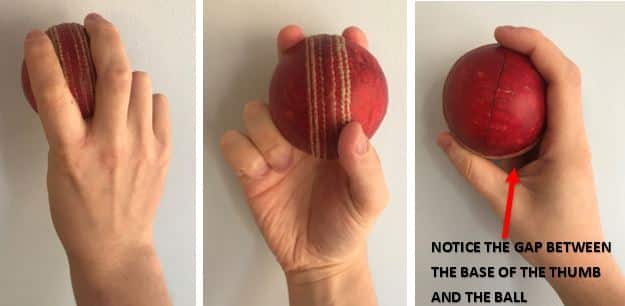
As I mentioned, there are many other ways that you can grip a cricket ball, and each one of these can allow you to do a different thing with the ball. These grips can allow you to get the ball to swing in the air, and also bowl slower deliveries. If you are interested in learning more about these different grips, click here to read the detailed post I’ve written on all of them!
Develop A Repeatable and Smooth Run Up
The run up is one of the most critical aspects of your bowling action. Getting it right can help you bowl faster and more accurately, so it’s definitely worth paying attention to!
The run up is where we build up all of the momentum that we use to propel the ball towards the batsman. Ideally, we want to transfer as much of this momentum into the ball as possible! To do this, try to make sure you achieve the following things with your run up:
- As you approach the crease to deliver the ball, you should have built up a decent amount of speed. It’s not necessary to sprint towards the wicket, but most bowlers usually reach around 60-70% of their top running speed. I usually describe the ideal speed of approach as ‘a brisk jog’.
- Don’t make your run up too long. Run ups are usually measured in paces, and the ideal number of paces for a fast bowler’s run up is between 10-25. I would suggest not making yours any longer than 25! This can be a huge waste of energy. As long as you can build up the required momentum within 10-25 paces, the length of your run up can be anywhere within that range.
- Try to keep your body aligned towards your target at all times. Some bowlers have a curve in their run up, and some will jump sideways slightly as they deliver the ball. In my opinion this is bad practice. Ideally, you want all of your motion going in a straight line towards the batsman! This is how you can get the most speed behind the ball, and I find that it helps me to be a lot more accurate too. Also, try not to swing your arms from side to side as you’re running in to bowl. Your arms and legs should be pumping up and down in a linear fashion. The more sideways movement we make, the more it can hinder our momentum and take away from our approach and delivery speed.
- Make sure you have a repeatable take off routine. This basically means that every time you start your run up, you should be doing it from the same point, and from the same foot. To do this, ensure that you measure out your run up properly, and make a mark on the field to tell you where to take off from. This mark can be made by scratching a line with your boot or laying down a marker.
It takes a lot of practice and repetition to get your run up to the stage where you don’t have to think about it anymore. This is the point you should be aiming to get to! If you’re running in to bowl and consciously thinking about where your feet are going to be landing instead of whereabouts you’re going to bowl, then this can be harmful to your bowling performance.
Learn To Swing The Ball
Getting the ball to swing is one of the deadliest weapons for a fast bowler. If you’re not sure what swing is, it is the name we use to describe what happens when the ball moves sideways in the air. For example, when the ball leaves the bowlers hand it may originally be travelling towards the leg stump, but swing could cause it to travel wide of the off-stump. Swinging the ball in this way makes it incredibly hard for batsmen to judge the line of the ball, and makes it much more likely that they will miss it or edge it through to the keeper/slip fielders. If fast bowlers can bowl controlled, accurate swinging deliveries, it makes them much more difficult to face!
There are 3 types of swing a fast bowler can achieve; Outswing, inswing and reverse swing. Some bowlers just have a natural ability to make certain types of swing happen, whereas other bowlers will have to practice the skill a lot harder. Throughout my cricket career I have never struggled to get inswing on the ball, it just seems to occur naturally because of my action! However, I struggled to get the ball to outswing away from the right handers! Thankfully, all bowlers can be taught how to swing the ball in different directions!
To learn how to get outswing on the ball I would follow these four main rules:
- Hold the ball in the correct outswing grip (shown below). Note that the seam should be pointing towards first slip.
- Make sure one side of the cricket ball is polished, and one side is rough.
- Place the rough side of the ball towards the direction that you want the ball to swing
- Try to make sure that your index finger is the last finger to make contact with the ball as it leaves your hand
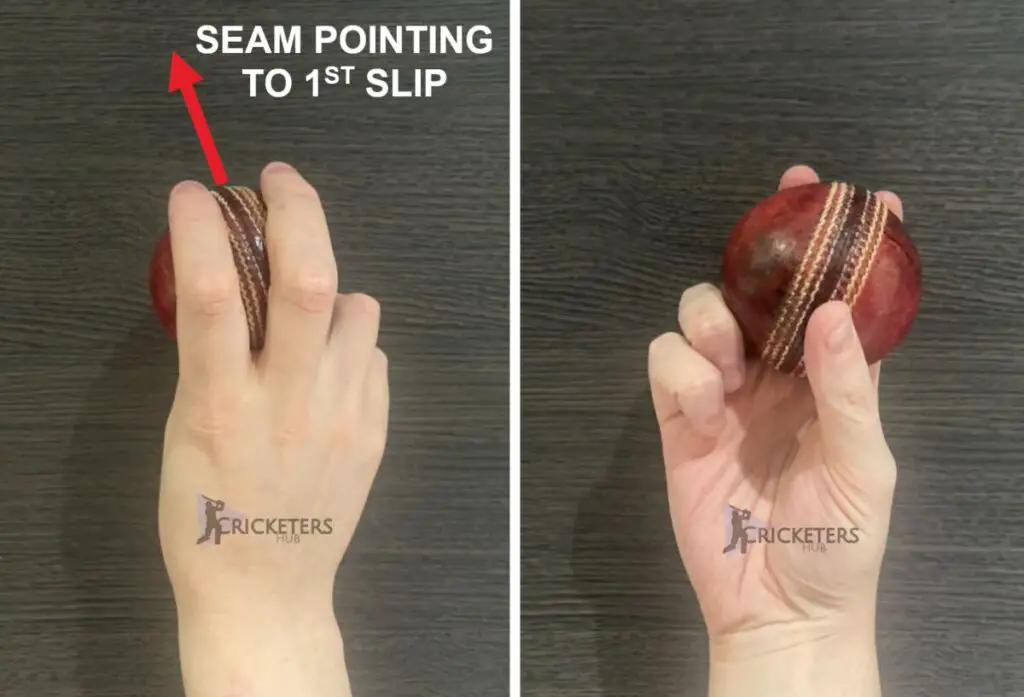
To learn how to get inswing on the ball I would follow these two main rules:
- Hold the ball in the correct grip for the inswinger (shown below)
- Make sure one side of the cricket ball is polished, and one side is rough.
- Place the rough side of the ball towards the direction that you want the ball to swing
- Try to make sure that your middle finger is the last finger to make contact with the ball as it leaves your hand
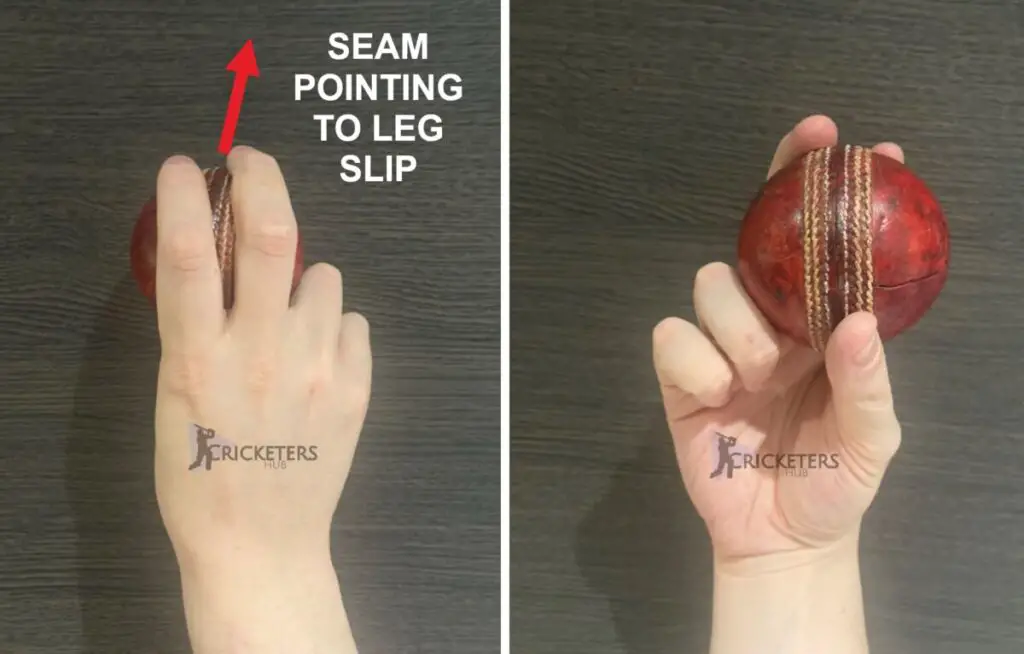
Reverse swing is slightly different, and much harder to achieve than inswing or outswing. If you want to get the ball to reverse swing you should follow these basic rules:
- Hold the ball in the basic fast bowling grip
- Ensure the ball remains as dry as possible. A wet or slightly damp ball will probably not reverse swing!
- The ball should be more than 25 overs old, with one side polished and kept in a relatively good condition, while the other side has been allowed to deteriorate and become very rough.
- The shiny side of the ball should be placed towards the direction that you want the ball to swing
- You will need to be able to bowl above 80mph if you want to reverse swing the ball. For better results, you should be able to bowl above 85mph. Increased speed makes reverse swing much more likely to occur.
Work On Improving Your Bowling Speed
If you’re a fast bowler that is looking to improve and become more dangerous, then you should definitely consider trying to add a little speed to your deliveries. This is especially true if you’re a young bowler who is still growing and getting stronger! Bowling at higher speeds forces batsmen to make faster decisions, and can help you to intimidate them and force them on to the back foot. Being a little scary as a fast bowler is never a bad thing!
One of my favourite things to do to improve your speed is to use your front arm more effectively! As you enter your delivery stride, most fast bowlers will move their front arm up towards their head, similar to the way I have shown in the photo below. From here, the bowler pulls down the front arm to kickstart the delivery of the ball from their bowling arm. If you can teach yourself to pull your front arm down towards the ground more forcefully, then your bowling arm will rotate much faster! This causes the ball to leave your hand at a higher speed.
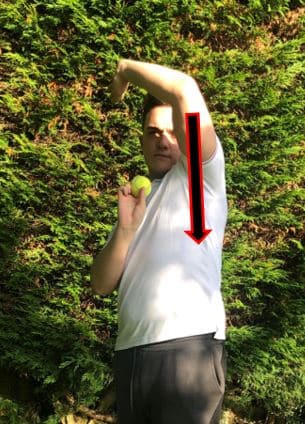
It’s also important that you don’t pull your front arm down too early. A lot of young players tend to do this! The longer you delay the pulling down of the front arm, the more in sync it will be with the rotation of the bowling arm! This means that more of the energy generated by the front arm can be used to aid the speed of the rotation! I’d definitely recommend working on this with your coaches if you’re looking to bowl a bit faster.
I have many other tips like this on this site. If you want to know what they are, click here to read my post where I share my 8 favourite methods for improving the speed of your bowling!
Develop A Great Yorker
In modern cricket, it’s vital that fast bowlers are able to bowl yorkers reliably and accurately in order to surprise the batsman and limit their scoring. If you’re not sure what a yorker is, it’s basically a quick delivery that pitches right on the batsman’s crease close to their feet. The zone in which fast bowlers should be looking to land their yorker delivery is shown in red in the image below!
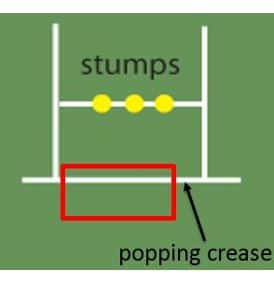
Yorkers are incredibly important when playing 20 and 50 over cricket because batsmen will be trying to play in much more attacking ways. The yorker makes it hard for batsmen to play attacking shots because when it reaches the batsman, it is making contact with the ground at the same time. This makes it almost impossible for a batsman to get their bat underneath a well-directed yorker to hit it for 4 or 6!
The best way to practice bowling the yorker is to get yourself a set of stumps, and just bowl and bowl and bowl. You don’t even need a batsman present to practice it! Just focus on getting the ball to pitch close to the stumps where the batsman’s feet would be. When I’m looking to practice my yorker I will often place a few cones along the line of the batsman’s crease so I have something to aim at. I’ll place one cone on a leg stump line, one on a middle stump line, and one wide outside the off stump so I can practice executing different things. Sometimes it’s better to bowl a wide yorker than one on the batsman’s pads!
If you want to know more about the yorker, I’ve got you covered. In one of my other posts I lay out a few different ways you can practice it, as well as when you should be looking to bowl it! Click here if you’re interested in reading it.
Practice Your Slower Balls
If you’re going to become a very skilful fast bowler, I’d also recommend choosing a type of slower ball to try and master. The slower ball is another bowling weapon that has become even more valuable as batsmen have become more attacking in recent years, and if you’re going to succeed as a fast bowler in the shorter formats of the game, you will need to be able to bowl a good one!
There are a number of different ones that you can choose from; the off cutter, the leg cutter, the split finger delivery and the knuckle ball are just a few of them! I wrote a post that gives you all of the info on each type of slower ball, as well as how you can bowl them, and you can read that by clicking here! There’s no better place to start if you’re just thinking about practicing them for the first time.
My favourite slower ball is the off cutter, which requires you to put a bit of spin on the ball as it leaves your hand. I wrote a complete guide on bowling the off cutter that you can read by clicking here, but basically, this action of putting spin on the ball makes it leave your hand a little slower than usual. This loss of pace is dangerous for a batsman because they may have gotten used to you sending down deliveries that are 80mph. If you then choose to bowl a slower ball, this may result in them playing their shot a little too early! Mistiming their shot in this way can lead to them hitting the ball up in the air or missing it altogether. That is why slower deliveries are so deadly!
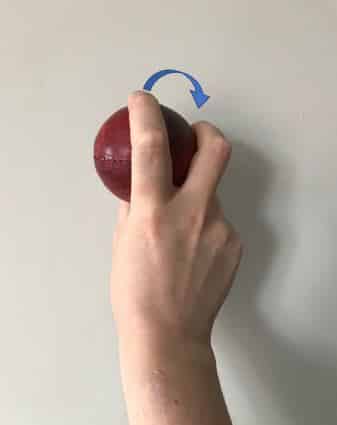
The key when bowling a slower ball is being able to bowl it accurately, and this accuracy can only be achieved through relentless practice! For all of the time you spend practicing your bowling, I’d recommend dedicating at least 20% of this time to practicing your slower ball. This is definitely true for bowlers who have just started using the delivery. For bowlers who have been bowling the slower ball for a while, it won’t require as much weekly practice!
Try To Keep Your Body Flexible – Especially In Key Areas!
Fast bowling puts an incredible amount of stress on the body, which means we are more susceptible to injuries. We have to keep our body as prepared for these stresses as possible, and one of the ways we can do this is through stretching and maintaining our flexibility.
Long periods of inactivity like sitting down for extended periods of time shortens our muscles and make them tighter, which can make it harder to immediately engage in physical activity. It makes our muscles more prone to damage! Stretching our key muscles prior to engaging in an activity like bowling in a cricket match helps to elongate them and make them more pliable. This helps to increase our range of motion, which can allow us to bowl faster and avoid injuries.
To keep our body and muscles healthy, we should try to stretch our muscles out regularly. For fast bowlers, particular attention should be paid to the lower body because this is the area under the most stress. Specifically, you should be aiming to stretch out the hamstrings, quads, calves and groin areas. I also find that my bowling feels much smoother if I stretch my back a lot!
If you really want to improve your flexibility in these areas, you should try to stretch them out daily. This is how you will see the most results! At a minimum you should be stretching once a week, and you should definitely make sure you include it as part of your bowling warm up.
If you’re looking for the specific types of stretches you should be doing, click this link to watch a great youtube video that should give you some ideas. You don’t have to perform the whole workout, but it will definitely give you some inspiration for individual stretches! Alternatively, you can just google things like ‘groin stretches’ or ‘hamstring stretches’.
Engage In Some Strength Training
If you want to be a quick bowler that can bowl at high speeds for long periods of time then it’s important to ensure that your body is strong and equipped for the challenge. Having a stronger body not only helps you to bowl faster for longer, it can also improve your ability to avoid injuries.
There are a few areas of the body which are especially vital to bowling fast. These are:
- Quadriceps
- Hamstrings
- Hip Flexors
- Glutes
- Abdominals & Core
If you can, I’d recommend getting yourself a gym membership and working on strengthening these areas of your body. If you can’t afford a gym membership, or you feel like it’s not something that you want to do, there will be some simple exercises you can do at home.
Here are some examples of exercises that you should try if you want to build strength in the areas I mentioned above:
- Leg extensions – Easy to do in the gym, you’ll often find a leg extension machine in there. These are great for targeting your quadriceps
- Lunges – these are a great alternative to leg extensions if you can’t make it to a gym. They also target your quadriceps as well as your glutes and hips
- Floor sliding mountain climbers – These are a great exercise you can easily do at home to build some strength in your hips
- Squats – Probably the best exercise on this list, it targets pretty much all of your lower body! You can perform this with added weight on a barbell in the gym, or just with your own body weight at home. Try jumping squats for an extra bit of explosiveness!
- Planks – Try out several variations of the plank in order to build some solid core strength. These exercises can easily be done at home or in the gym
- Rotational Medicine Ball Throws – Rotational power is important for fast bowlers. Rotational medicine ball throws help to build this type of power and can easily be done if you have a medicine ball and some soft space.
Feel free to google any of the exercises above for some more information on how to properly perform them. Also remember with all resistance exercises, never try to lift/throw a lot more weight than you’re capable of. This can put too much stress on your body and lead to injuries! For fast bowling, you want to be lifting relatively challenging weights with high numbers of repetitions, as well as aiming to move the weight quickly to improve your explosiveness.
If you perform these kinds of exercises regularly (at least once a week) you should eventually see a difference in your body and in your ability to bowl fast.
If you want more information on the kinds of exercises you should be using to improve your fast bowling abilities then I’d recommend speaking to a qualified fitness trainer!
Find Some Bowling Drills You Can Do In The Nets Or At Home
You don’t always need to bowl at a batsman when you’re trying to practice your bowling skills. You can create a number of drills to use when you’re practicing by yourself/without a batsman. It’s always good to have a few of these up your sleeve!
Here are a few ideas:
Stationary Target Practice Drills
These are my favourite type of bowling drill because they’re so effective and help you to improve arguably the main aspect of your bowling: your accuracy.
You can use cones as targets, placing them in the area you want to bowl such as on a good length, on a yorker length etc. You could also choose to use a coin of some sort! This is a much smaller target that will be harder to hit.
Another kind of target practice I’ve used in the past is to have a partner place some money (coins) on the top of the off stump, and let me try to knock it off! I’ll usually give myself 6 balls to try to hit the top of the off stump. If I can hit it, I keep the money! If not…I miss out. It’s a nice little incentive!
Moving Target Practice Drills
Sometimes we need to practice bowling against moving targets, in case the batsman chooses to change position at the last second. In this situation, we may try to change where we are going to bowl at the last second and follow the batsman across the crease.
One moving target drill that I like to do is to get a partner to roll a football from left to right (or right to left) across the crease just as I’m about to bowl. I have to judge the movement of the football and try to hit it with the ball.
This is a nice little drill because it requires us to anticipate the movement of the ball and react on the fly. This is something we have to do regularly in game situations.
Run Up Drills
If you don’t have a partner to bowl to, you can always mark out your run up and practice going through that aspect of your bowling action! As I mentioned earlier, repetition is vital when it comes to the run up so the more practice and drilling you can do the better!
There are many more types of drills that you can try, and like I said, it’s always worth having a few that you can rely on when there’s no one to bowl to!
Think & Learn About The Tactical Side Of The Game
A lot of bowlers overlook this part of the game but I think it’s hugely important. You should always be trying to improve your cricket smartness and knowledge of the tactical side of the game, because it can give you a big edge over the batsmen you’re bowling to!
Start to think about your bowling plans to individual batsmen and how you are trying to get them out. A lot of inexperienced bowlers tend to just run up and bowl with no thought of what they are trying to achieve, but in my opinion you should always be thinking of your end goal. For example, if you know you’re going to run up and bowl several yorkers, ask your captain to move the fielders a bit straighter and focus on sneaking your yorker past the defences of the batsman. If you want to suffocate a batsman who is strong when playing through the leg side, force yourself to bowl wide of the off stump and work with your captain to set an off side field! Little things like this can make you a much more awkward bowler to face.
The more experienced you become, the better you will get at spotting the weaknesses of certain batsmen. For example, you may start to notice if a batsman plants their front foot across to the off side before the ball has been delivered. If you see this, you will begin to learn that this batsman will probably struggle against quick, straight deliveries that are targeting the pads! If you notice that a batsman does not move their feet much at all, then you may want to hang the ball outside the off stump and try to get them to drive at the ball. The lack of foot movement will make them more susceptible to an outside edge!
To notice these things about a batsman’s technique, it helps to have a great knowledge of the game. I’d recommend watching a lot of cricket and listening to the commentators analyse the professional players’ techniques. This is where I gained a lot of my knowledge! Also, make sure you keep coming back here to Cricketers Hub because I’ll be sharing a lot more technical knowledge if that’s what a lot of you are interested in!
Commit To Practicing Regularly
If you want to be a great fast bowler, you’re going to have to work hard to get there! I can’t make it any simpler than that. A lot of bowlers find it easy to get their practice sessions in while the cricket season is ongoing, but a lot of them find it harder in the winter months when there isn’t as much cricket going on!
If you want to see real improvements quickly, then you should think about doing some of the following things:
- Make sure you’re practicing your bowling for at least one hour per week during the cricket season. In my opinion, you shouldn’t ever dip below this amount of practice unless you’re injured!
- If you can, try to get multiple days of practice in per week. Try to find somewhere you can practice at home as well as with your cricket club!
- Remember that the winter months are just as important as the summer months. If you work hard on your bowling for 6 months, then don’t bowl again for 6 months over the winter, you won’t see much progress! If you can, avoid these peaks and valleys in your training and find a way to work on your bowling in the winter. Indoor cricket nets are a great way to do this!
- Remember not to bowl too much! This can put you at a lot higher risk of injuries and that is not a situation you want to be in. In any 7 day period you shouldn’t be bowling more than 4 days in total in that period. I also recommend bowling for a maximum of 2 days in a row!
Conclusion
These tips cover all of the basics that you’re going to need if you want to become an elite fast bowler in modern cricket. Like I said earlier, if you’re committed and work at your craft regularly, then you’ve got a great chance of improving rapidly. No matter what level of cricket you play, you should always be trying to raise your game because let’s face it, it’s fun to take wickets…and it’s fun to win! I hope this post has given you a bit of inspiration as to the different things you can focus on, and how to get started. Let me know in the comments if you think there’s anything I missed and in the meantime, good luck!
